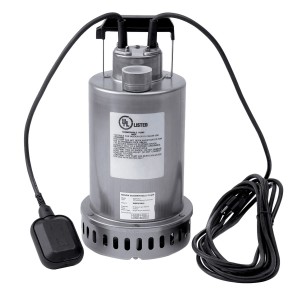 Honda may be synonymous with internal combustion engines, but their WSP53 Submersible Pump uses a 1/2 hp electric motor to keep basements, crawl spaces and other flood-prone areas dry. This guide will show you how to keep your pump working trouble-free and get it running again when problems do arise.
Honda may be synonymous with internal combustion engines, but their WSP53 Submersible Pump uses a 1/2 hp electric motor to keep basements, crawl spaces and other flood-prone areas dry. This guide will show you how to keep your pump working trouble-free and get it running again when problems do arise.
Protecting Your Pump and Yourself
Obviously, the pump should be turned off and unplugged before performing any repairs. What isn’t obvious is how it should be moved: the handle is designed primarily to be used as a place to tie a rope for lifting and lowering it into places where water needs to be moved. Always lift the pump using this rope and never the power cord.
This pump is designed to handle clean water up to 122°F (50°C) with suspended solids up to 3/16 of an inch (4.8 mm) in diameter. If the body of water you’re pumping from has a bottom layer of rocks and other debris, support the pump from the top to keep if off the surface. Even with these precautions, hard debris like sand will shorten the life of the pump. The motor needs to be surrounded by water to stay cool, so the pump should stay submerged when operating.
The pump needs to be operated with a GFCI breaker or fuse rated at a minimum of 15 amps. Maximum distance between the pump and the breaker or fuse should be no more than 100 feet (30.5 m) to keep resistance in check. Voltage 10% more or less than the rated voltage on the pump can damage the motor: although not normally a problem when getting power from utilities, it pays to check the settings when using a generator.
The warranty on this pump is void if the motor housing, impeller or impeller seal are removed. All do-it-yourself maintenance and troubleshooting can be done without interfering with these parts.
Maintenance
Most problems can be solved by cleaning debris that has built up on the float, impeller and volute case. How often this needs to be done depends entirely on how dirty the water is.
Cleaning the Float
Over time, build up of debris can jam the float switch. Cleaning is simply a matter of lifting out the pump and wiping down the switch. Once cleaned, the switch should move freely.
Cleaning Impeller and Volute Case
Remove the screws that hold the lower part of the base to the housing, then gently pry the base and housing apart using a flat head screwdriver. After removing any debris in the case and pump base holes, make sure the impeller can spin freely.
Common Problems and Solutions
Pump doesn’t run or hums
– The circuit breaker is off or the fuse is either blown or loose.
– The Water level in the sump is not high enough.
– The pump cord is not fitted properly
– The Float is stuck.
– There are debris stuck in the impeller.
– The motor winding is open or the capacitor is defective.
Pump runs, but isn’t moving water
-Check that the valve is installed correctly. The arrow should be pointing toward the direction of flow.
– If the discharge shut-off valve is being used, it may be closed.
– The pump is air-locked. Start and stop the pump repeatedly by plugging and unplugging the power cord. Check the case vent hole for clogs.
– The impeller or volute openings are clogged and need to be cleaned.
– The vertical pumping distance (head) is too high. Reduce the distance, or switch to a larger pump. The maximum head for the WSP53 is 44 feet (13.4 m.)
Pump won’t stop moving water
– The float is stuck in the up position. Clean it and make sure it can move freely.
– The float switch is defective.
The pump only delivers small amounts of water
– The pump is air-locked. Start and stop the pump repeatedly by plugging and unplugging the power cord. Check the case vent hole for clogs.
– The vertical pumping distance (head) is too high. Reduce the distance, or switch to a larger pump. Reducing the head even a few feet can drastically improve performance.
– The inlet holes, impeller opening or volute opening is clogged and needs to be cleaned.
The fuse blows or the circuit breaker trips when the pump starts.
– The impeller is clogged, causing the motor to overload.
– The fuse or breaker is rated at less than 15 amps.
– The stator is defective.
– The impeller or volute openings are clogged and need to be cleaned.
– There is water inside the pump motor.
Motor runs briefly, then stops
– The inlet holes, pump impeller or volute openings are clogged and need to be cleaned.
– The motor isn’t submerged, causing it to overheat.
Where to buy Honda Pump parts
www.hondalawnparts.com is a full line OEM dealer of Honda small engine products including electric devices like the WSP53 pump. Whether you need OEM parts such as O-rings, screws or a whole new motor, they can get it to you no matter where you’re located.
